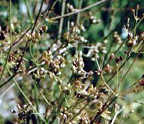 Growing up in a household that was strong on Eastern European cooking, I’ve always associated caraway with hearty meals and cold weather. Maybe that is because it is a common ingredient in robust winter dishes such as Hungarian stews and German sauerkraut or boiled cabbage. Maybe it is because the sharp flavour of caraway—a cross of anise and dill—is the perfect counter-point, in deli rye bread, to the fat in a good smoked meat sandwich which I find tastes best after a long walk down the Main on a blustery day. Growing up in a household that was strong on Eastern European cooking, I’ve always associated caraway with hearty meals and cold weather. Maybe that is because it is a common ingredient in robust winter dishes such as Hungarian stews and German sauerkraut or boiled cabbage. Maybe it is because the sharp flavour of caraway—a cross of anise and dill—is the perfect counter-point, in deli rye bread, to the fat in a good smoked meat sandwich which I find tastes best after a long walk down the Main on a blustery day.
Caraway is related to the parsley. Chew a couple of seeds and you’ll notice an astringency similar to parsley leaves. Both plants are still eaten in many cultures after meals to freshen the breath and help digestion. Caraway flavoured candies, called comfits, are sometimes known as “whiskey killers” since their aroma helps mask alcoholic breath.
Caraway is one of the oldest plants cultivated in Europe. In Switzerland, its seed was found in 5000 year old ruins. It was featured in many medieval dishes. A Shakespearen character served caraway seeds with “a pippin of my own graffing” and in his time roasted apples was commonly accompanied by caraway. It was also a popular addition to love potions since it was said to help protect against evil.
Today caraway’s taste is featured in foods as varied as Christmas cookies, Alsatian and Dutch cheeses and the clear German liqueur kümmel. A simple dish that emphasizes the flavour of caraway is to sprinkle a spoonful of the seeds over boiled potatoes. Let them sit covered for a few minutes and then drizzle melted salted butter over it all just before serving. 
|

